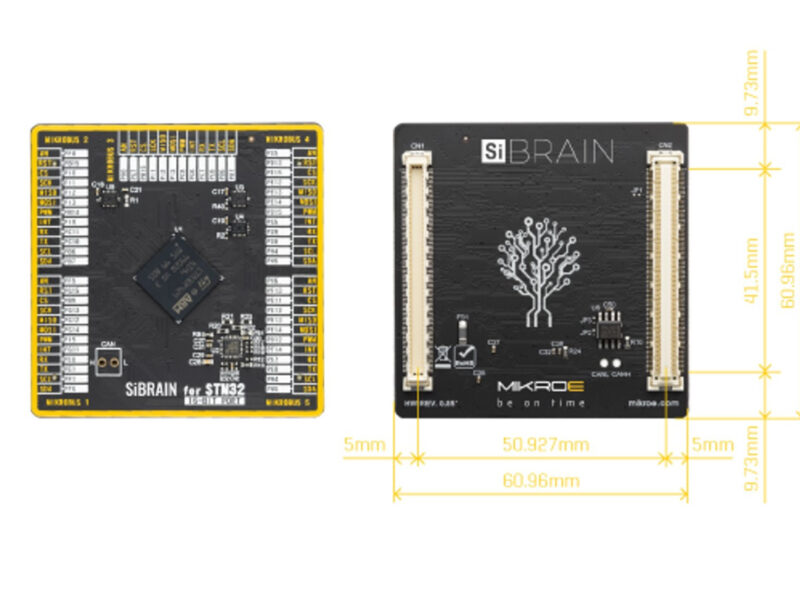
SiBrain module takes on microcontrollers
MikroElektronika in Serbia has launched an open board standard that it says will accommodate any microcontroller. It plans to make over 1000 modules over the next two years with a wide variety of controllers and FPGAs.
The SiBrain standard builds on approach taken by the popular ClikBus peripheral boards.
“What we are talking about is a socket and add on board standard for different microcontrollers,” Nebojsa Matic, CEO and founder of MikroE told eeNews Europe. “Each silicon vendor believes they have the best solution on how to bring a microcontroller on aboard. Because there is no standardization, for every different microcontroller there is a specific set of operating instructions, new tools to learn, new boards and licenses to buy and new processes to adopt.”
“MicroE had a format that was good to 80pins [with MikroBus for peripheral cards], but we wanted to make a universal MCU card standard from the smallest to the biggest as well as microprocessors for Linux, all kinds of controllers. So we went through thousands of PDFs and looked at everything. We tried 100 different boards and finally show that it is possible to place any processor on the standard. There are 10,000 microcontrollers and probably 100 different MCU card standards and we want to change that.”
The resulting SiBrain standard measures 60 x 60 with two high speed 168pin connectors from Hirose for reliability. “That’s enough pins for even the biggest microcontrollers with 330 pins, and we have already have PIC18, 24, PIC32, AVR, Kinetis, a RISC-V Chinese chip, a Mediatek chip with Azure Sphere, and FPGAs are in the plan.”
“It’s an open standard and we will give people Altium files so companies that want to produce cards can do that, or place a socket on a card,” he said. The cards can be used for development systems with carrier cards as well as small run production systems.
Related MikroE articles
- EtherCAT mikroBus board
- Toshiba teams for motor control boards
- mikroBUS-compatible board enables wired IoT
- STMicro extends motor driver modules
“We didn’t ask for this role in the industry but someone needs to do it,” said Matic. “Silicon vendors don’t want standardisation, they want customers to stick with their dev tools and microcontrollers but that’s not real life. We make development tools for customers, and sell 80 percent to companies and 20% to universities and hobbyists. We sell time. We free up time as an engineer for something else. You can change a microcontroller without any hardware penalty and how the system works with an ARM M4, M7, RISC-V, or Linux. Just switching the SiBrain card allows you to do that.”
“I don’t know any standard that covers 100% of all applications but we bet there are no bigger processors with more than 330 pins so we think we are pretty safe for the future. We think we cover 95 percent of applications. We plan to have 1000 of these cards in the next two years and that’s 8.5tn unique combinations of SiBrai modules and carrier cards.”
He says he is open to working with other industry standards such as SMARC from SGET, part of PICMIG, which has two similar sized board standards. “We didn’t reach them yet but we will work with them on any standardisation where we can help,” he said.
Other microcontroller module articles
- Raspberry Pi uses its own silicon for $4 pico board
- Raspberry Pi shortage driven by demand
- SMARC module with the NXP i.MX 8M for edge AI
- RISC-V FPGA SoM module starts production
- COM Express module jumps to 11th gen Intel Core processors
- AMC module with quadcore NXP Layerscape processor
Other articles on eeNews Europe
- Top ten chip market boom for 2021
- Why is the chip shortage getting worse?
- Kalray teams for multicore storage card in cloud and edge
- Bosch powers up chip production in Dresden
 If you enjoyed this article, you will like the following ones: don't miss them by subscribing to :
eeNews on Google News
If you enjoyed this article, you will like the following ones: don't miss them by subscribing to :
eeNews on Google News



